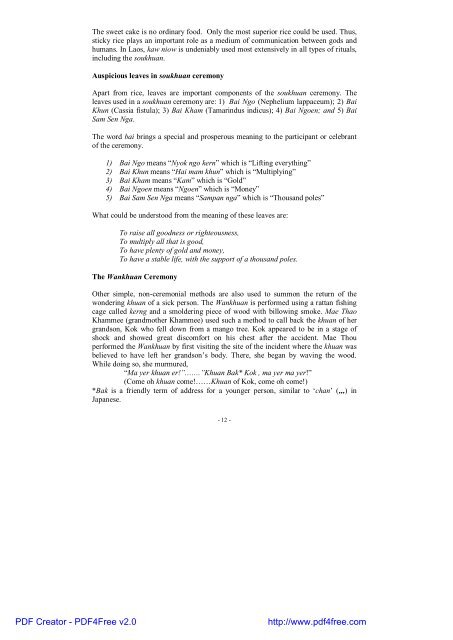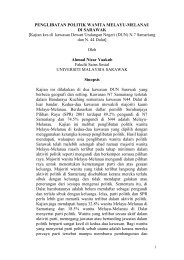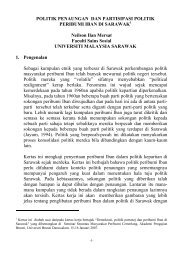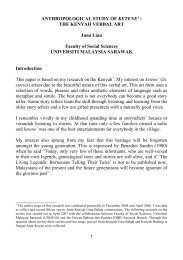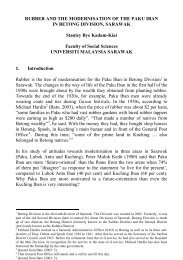OF SOUKHUAN AND LAOS Elena Gregoria Chai Chin Fern Faculty ...
OF SOUKHUAN AND LAOS Elena Gregoria Chai Chin Fern Faculty ...
OF SOUKHUAN AND LAOS Elena Gregoria Chai Chin Fern Faculty ...
Create successful ePaper yourself
Turn your PDF publications into a flip-book with our unique Google optimized e-Paper software.
The sweet cake is no ordinary food. Only the most superior rice could be used. Thus,<br />
sticky rice plays an important role as a medium of communication between gods and<br />
humans. In Laos, kaw niow is undeniably used most extensively in all types of rituals,<br />
including the soukhuan.<br />
Auspicious leaves in soukhuan ceremony<br />
Apart from rice, leaves are important components of the soukhuan ceremony. The<br />
leaves used in a soukhuan ceremony are: 1) Bai Ngo (Nephelium lappaceum); 2) Bai<br />
Khun (Cassia fistula); 3) Bai Kham (Tamarindus indicus); 4) Bai Ngoen; and 5) Bai<br />
Sam Sen Nga.<br />
The word bai brings a special and prosperous meaning to the participant or celebrant<br />
of the ceremony.<br />
1) Bai Ngo means “Nyok ngo kern” which is “Lifting everything”<br />
2) Bai Khun means “Hai mam khun” which is “Multiplying”<br />
3) Bai Kham means “Kam” which is “Gold”<br />
4) Bai Ngoen means “Ngoen” which is “Money”<br />
5) Bai Sam Sen Nga means “Sampan nga” which is “Thousand poles”<br />
What could be understood from the meaning of these leaves are:<br />
To raise all goodness or righteousness,<br />
To multiply all that is good,<br />
To have plenty of gold and money,<br />
To have a stable life, with the support of a thousand poles.<br />
The Wankhuan Ceremony<br />
Other simple, non-ceremonial methods are also used to summon the return of the<br />
wondering khuan of a sick person. The Wankhuan is performed using a rattan fishing<br />
cage called kerng and a smoldering piece of wood with billowing smoke. Mae Thao<br />
Khammee (grandmother Khammee) used such a method to call back the khuan of her<br />
grandson, Kok who fell down from a mango tree. Kok appeared to be in a stage of<br />
shock and showed great discomfort on his chest after the accident. Mae Thou<br />
performed the Wankhuan by first visiting the site of the incident where the khuan was<br />
believed to have left her grandson’s body. There, she began by waving the wood.<br />
While doing so, she murmured,<br />
“Ma yer khuan er!”…….”Khuan Bak* Kok , ma yer ma yer!”<br />
(Come oh khuan come!……Khuan of Kok, come oh come!)<br />
*Bak is a friendly term of address for a younger person, similar to ‘chan’ ( ) in<br />
Japanese.<br />
- 12 -<br />
PDF Creator - PDF4Free v2.0<br />
http://www.pdf4free.com


